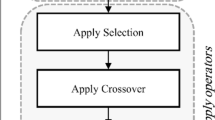Abstract
This article proposes a novel genetic algorithm (GA) which switches the expression of the solution from a redundant binary number to a usual binary number. Furthermore, a GA which switches the expression from the Gray code to the usual binary number is proposed and compared. Comparisons of the performances among five GAs (binary number, redundant binary number, Gray code, switching from redundant binary number to binary number, switching from Gray code to binary number) are illustrated. The performances are evaluated by solving some equations. It is confirmed that the proposed GA effectively decreases the error rate.
Similar content being viewed by others
References
Davis L (ed) (1991) Handbook of genetic algorithms. Van Nostrand Reinhold, New York
Tsukahara A, Kanasugi A (2009) Genetic algorithm with dynamic variable number of individuals and accuracy. Int J Control Autom Syst 7:1–6
Yao X, Liu Y, Lin GM (1999) Evolutionary programming made faster. IEEE Trans Evolut Comput 3(2):82–102
Author information
Authors and Affiliations
Corresponding author
Additional information
This work was presented in part at the 15th International Symposium on Artificial Life and Robotics, Oita, Japan, February 4–6, 2010
About this article
Cite this article
Murayama, A., Kanasugi, A. A novel coding method for genetic algorithms based on redundant binary numbers. Artif Life Robotics 15, 306–308 (2010). https://doi.org/10.1007/s10015-010-0752-4
Received:
Accepted:
Published:
Issue Date:
DOI: https://doi.org/10.1007/s10015-010-0752-4




